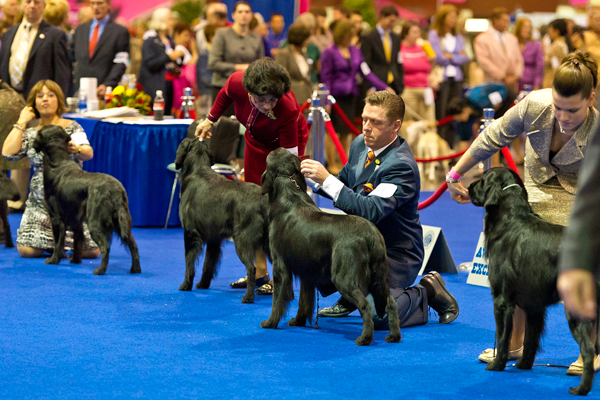
Much about dogs can translate from one breed to another. Soundness and basic structure is not that different among many breeds. Structural soundness in a Dalmatian is not that different from structural soundness in a German Shorthaired Pointer, for example. Type, outline, breed personality, and all of the little things that make each breed unique are much more difficult to learn about: How exactly does a Lhasa Apso breeder learn about the important differences in head type between the Flat-Coated Retriever and the Golden Retriever?
It has taken me more than 30 years to learn what I know about my breed. People hoping to complete their requirements for judging the Sporting Group do not have 30 years to learn the nuances of each and every breed in that or any group.
Several years ago I was asked to be judges’ education chairperson of the Flat-Coated Retriever Society of America. As a longtime exhibitor it has always been clear to me that many AKC judges, at least in my breed, still are in need of a good deal of educating. My breed is small in numbers, and judges are likely to see only a few at any given show.
When I became chairperson for judges’ education, I found that the club had no real program for presenters to use. There was a set of overhead drawings and photos that the previous chairperson had put together, a list of books on the breed, and little else. The club had recently completed an illustrated standard, which became my primary and most important resource and handout.
The next thing we did was put together a PowerPoint presentation that could be used by various presenters in any part of the country. This was accomplished by a small group of knowledgeable breeders supported by a computer-literate friend and club member.

Learning Opportunities for All
More important still is actually being able to see dogs. We are lucky and unlucky in our small breed to have only one specialty annually, which is our national.
Everyone goes to our national. Depending on location we will have somewhere between 300 and 600 dogs entered every year. This is a huge opportunity for prospective judges and also those already approved for our breed to come and see many dogs. There is no educational tool more important than being able to see and go over many quality dogs.
During our specialty we have a seminar for interested prospective judges. We also provide ringside mentoring done by a group of longtime breeders. Switching up people throughout the specialty (ours generally runs for three days) gives prospective judges the opportunity to talk to different people and get different opinions and perspectives on various issues. Mentoring enables participants to discuss dogs, placements, the breed standard, and ask questions about the things they do not totally understand.
Mentoring is a learning experience for everybody, mentor and prospective judge alike. I’ve often had people ask me questions about things that I’ve never even thought of. It is a good opportunity for everybody involved to learn more about the breed. It also gives people a good opportunity to discuss the presentation, to ask questions about anything that might not have been clear, and to give us feedback.
I highly recommend that all experienced breeders try to invest some time in judges’ education for their parent club. As breeders, our task is to breed the very best dogs that we can. In our judging system, many of us rarely see a breed specialist. Involvement in judges’ education can help ensure that those passing on our dogs have the tools to help them find the very best. Many of those rewarded in the show ring will eventually be used in our gene pools.
We hope that by helping judges to choose the very best, we help breeders to breed the very best. —H.S.
Helen Szostak, DVM, is a breeder of Flat-Coated Retrievers and was recognized by the American Kennel Club as the Sporting Group Breeder of the Year. She is a lifetime member of the Flat-Coated Retriever Society of America.
For more “Advice from the Breeder” columns, see our Breeder Education pages.

